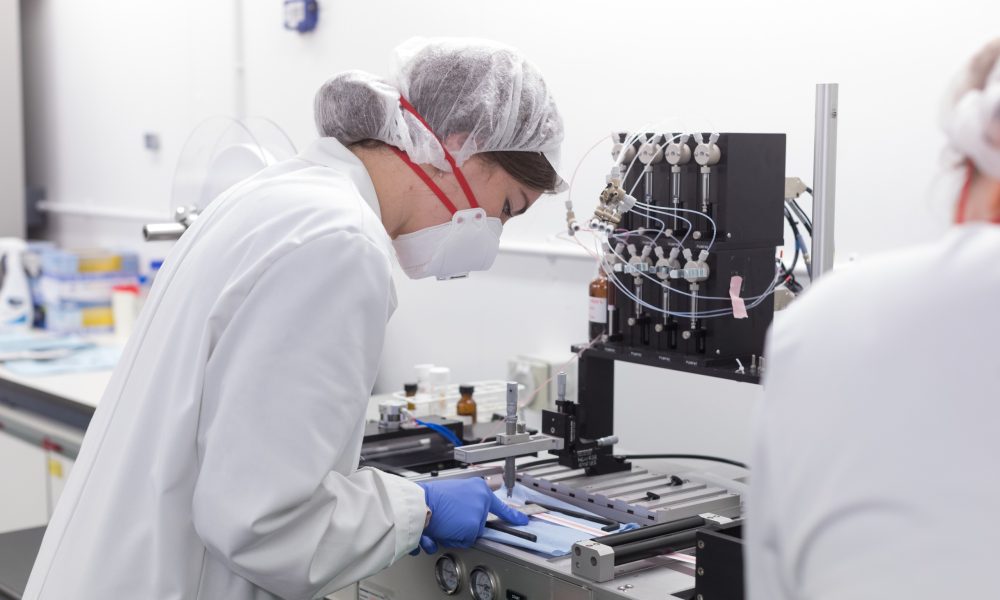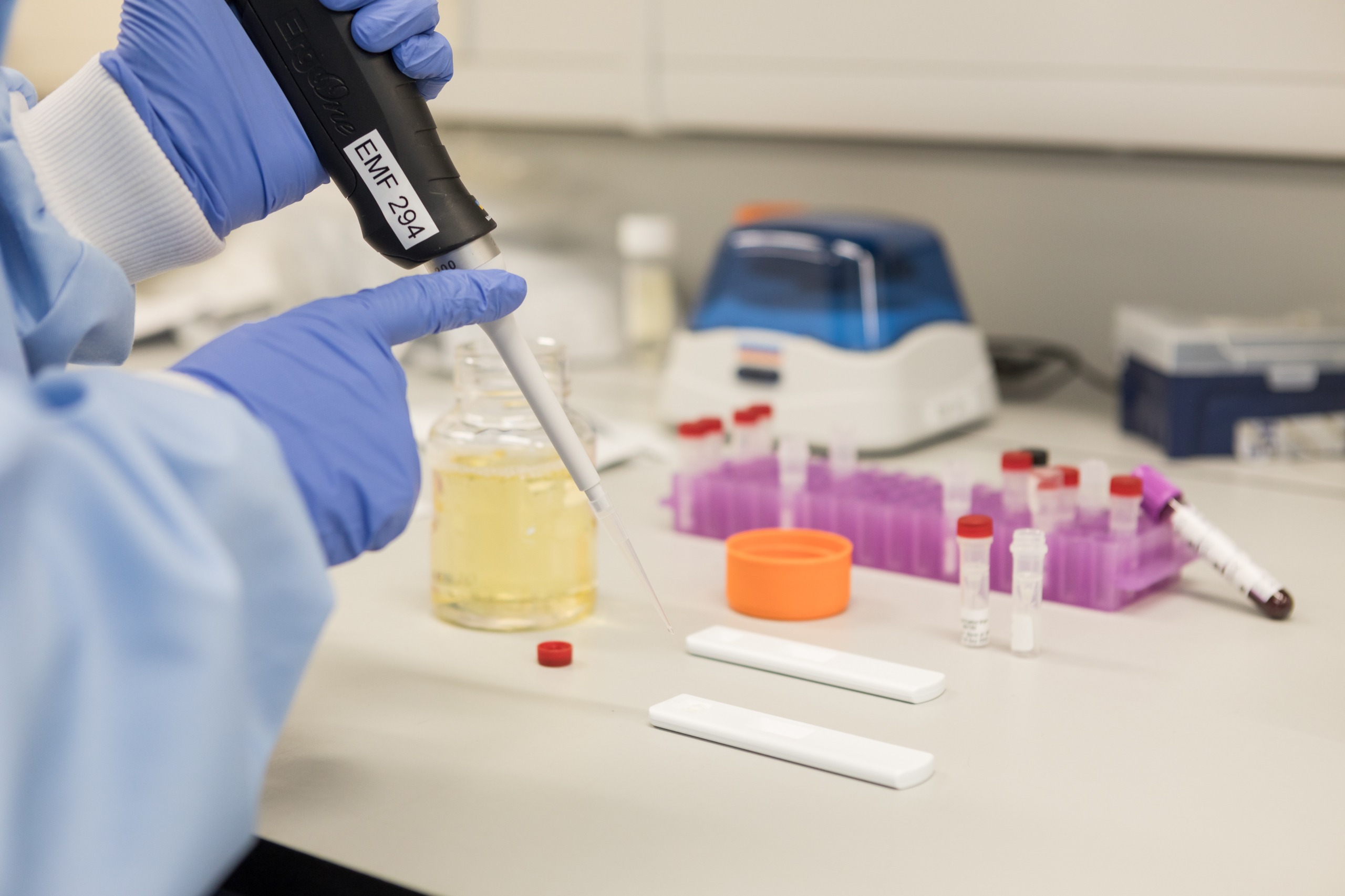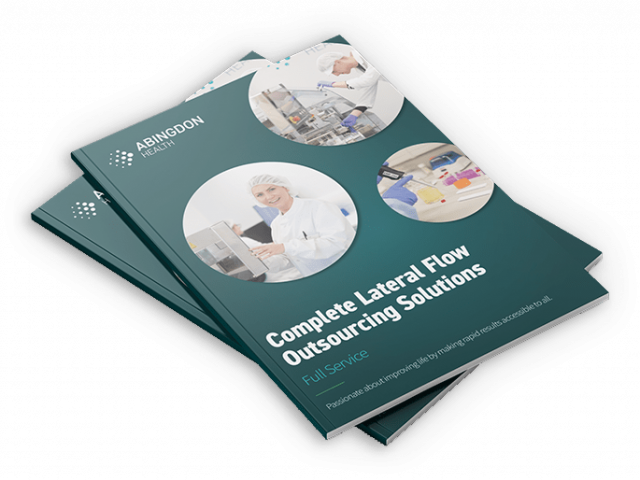Lateral Flow Tests: Past, Present & Future

LFT Technology: A Quick Overview
Assay Types in a Growing Market
LFT Evolution…
Looking at Labels
The Future Looks Bright for LFT
Key Takeaways
As part of our exhibition at MEDICA – the internal medical trade fair this year, taking place in Dusseldorf, Germany – our chairman, Dr Chris Hand delivered a talk today on Lateral Flow Tests: Past, Present & Future in the Medilink pavilion. Chris is an Oxford educated immunobiology doctor and industry veteran who has seen this industry develop and flourish. If you missed his seminar, the article blog covers the highlights.
Lateral flow tests (LFTs) gained widespread acceptance and use during the COVID-19 pandemic, previously being mostly known and used for pregnancy testing.
LFT Technology: A Quick Overview
Lateral flow testing has been used for many years as a low-cost, powerful, rapid, flexible, on-site diagnostic technology. The method can be used to detect single biomarkers and has a multiplex capability. Systems can be qualitative, semi-quantitative or quantitative with visual reads or via readers or smartphone apps for quantification. As with other immunoassays, LFTs can be formatted in competitive or sandwich assay format. The technique is now used with multiple sample matrices; with an expanding array of signal generators or ‘labels’ including gold, coloured latex, carbon and fluorescent labels and in myriad formats to suit different applications and user experience(s). Applications include those for infectious and chronic diseases, general health and wellbeing conditions, cardiac markers, drugs, hormones as well as veterinary, agricultural and environment applications.
The first commercial use of LFTs was for the detection of pregnancy by measuring the hormone hCG in a woman’s urine. This technique was commercialised in 1988 as Clearblue® which continues to be a market leader for pregnancy tests. However, the science behind LFTs dates back to the 1950s and the invention of radioimmunoassay by Rosalyn Yalow and Solomon Berson which they published in 1960 for the detection of insulin in human plasma. This invention laid the foundations for all immunoassays and LFTs, with pregnancy LFTs now offering rapid results in a wide range of formats including those with a visual read or digital systems which can indicate length of time of pregnancy. Most LFTs for pregnancy still rely on the use of urine, but advances in assay performance are allowing more convenient sample types.
Assay Types in a Growing Market
The market for lateral flow tests is undergoing a second wave of innovation in the wake of COVID-19 with increased awareness of the technology and user familiarity aiding the market growth and the uses to which LFTs are being applied growing. The flexibility of LFT means it can be applied to most molecules to which an antibody (or other binding moieties such as Aptamers or Affimers) can be raised. The vast majority of LFTs use antibodies as binding system. Small molecules such as drugs of abuse or steroid hormones will be analysed using a competitive assay format where the test line’s colour intensity decreases with increasing concentration of analyte in the sample. This is due to the analyte competing for antibody binding and associated signal generation at the test line. Larger analyte molecules, with more than one binding site or epitope, will be analysed via a sandwich assay format where test line intensity increases with increased analyte concentration due to the analyte forming a sandwich between antibodies at the test line and liquid-phase labelled antibodies.
These basic functions of immunoassay have been applied to LFT since the first Clearblue® pregnancy test, but the evolution and innovation in the field have led to a vast array of improvements in the technology which in turn leads to increased diagnostic applications. Advances in materials – both physical, biological and chemical – mean that sample matrices beyond urine are widely used in LFTs. The LFT architecture includes many pads and membranes which can be selected to allow use with more difficult samples such as whole blood, saliva (oral fluid) and even sweat. A vast array of other matrices can be used with LFT including plant material, milk, faeces, veterinary and environmental samples, and powders. If a sample can be made soluble, it can generally be tested by LFT.
Advances in sample pad and membranes; increased sensitivity by, for example, use of fluorescent signals or particles; and signal enhancers such as use of complexes like poly-lysine or poly-streptavidin-biotin systems, together with an improved choice and combination of antibodies are driving improved performance and thereby extending the application of LFT. The use of instruments to read the results, over and above visual reading, further extends the use cases of LFT.

LFT Evolution…
The continued evolution of LFT, can be illustrated with the example of the drugs of abuse (DoA) testing market. The first on-site drug tests used urine samples, and the vast majority still do; but the original, basic single-drug and multiplex-drug dipsticks have developed to more integrated drug testing cups which can test for many drugs simultaneously. These drug-test cups include other features such as markers to show sample adulteration and mechanisms to allow a portion of the sample to be sent to a laboratory for confirmation of positive results.
The use of adulteration tests illustrates one problem with urine drug tests – the need to produce a trusted sample often requires the subject to be observed when producing the urine sample, and in some locations such as at the roadside or in a workplace or criminal justice setting this is difficult or inconvenient. The advent of increased analytical sensitivity of LFT, including better labels, antibodies and a hand-held LFT reader allowed the ability to use saliva as a specimen and remove many of the issues around urine collection for DoA testing.
The outcome of these combined innovations led to the launch in the late 1990s of the first saliva-based DoA testing system: the Cozart RapiScan®, a multiplexed DoA system for use with saliva samples. This allowed use where DoA testing was previously difficult, such as in police custody suites, at the roadside and in clinical and workplace environments. Further innovations enhanced the user experience of the Cozart system which allowed easier roadside use and now, following a series of company acquisitions, the system has evolved to the Abbott SoToxaTM. The technology continues to evolve with current and future systems using saliva samples for roadside DoA testing such as the Drugwipe®, and the combination of high-sensitivity multiplexed fluorescent assays and portable fluorescent readers, meaning that drugs can be detected in fingerprint sweat without the need for any other (more invasive) sample collection.
We have seen with the DoA example above, that the drivers for improved assays – and therefore an improved user experience – can deliver commercial success across multidisciplinary boundaries. Signals and particles, and readers represent two elements of this multidisciplinary evolutionary approach.
Looking at Labels
A signal generator, or ‘label’, is how the result of a lateral flow test is read. The signal is ultimately located at the test and control lines to allow results interpretation either visually, or by a smartphone app or LFT reader. Labels include those derived from colloidal gold, carbon, latex particles, or fluorescence substances or particles. Choice of label can enhance sensitivity and improve assay performance. For device manufacture, particles such as gold nanoparticles should be capable of high-volume production and be uniform and stable.
Gold, coloured latex and carbon are commonly used for visual assays. A variety of sizes of gold are available, generally 20nm to 100nm and size can affect sensitivity. Gold can be read visually, but is also compatible with most reflectance, absorbance and camera-system lateral flow test readers, including smartphones. Latex is flexible as – like gold – both covalent coupling and passive conjugation methods are possible. This multi-coloured option lends itself as a good choice for visual multiplexing: one example of this is the Hydrosense Pro® device for the detection of Legionella sp in environmental samples which utilises different coloured particles to show different Legionella sub-groups.
Readers have evolved since the hand-held Cozart RapiScan® which used a patented CCD array system to capture the multi-plexed LFT image. Current portable desk-top readers such as the Axxim AX-2X-S reader can measure both colorimetric and fluorescent signals. Fluorescence will improve the sensitivity of a lateral flow test and has been reported to increase sensitivity by 7 to 300 times versus gold. Application of this enhanced sensitivity is ideally illustrated in the DoA example where the use of highly sensitive assays allows the use of sweat from a fingerprint as sample matrix.
In parallel with the improvements to labels and readers, we are seeing the increased use of smartphones as LFT readers – allowing objective reading, but also use of the connectivity, patient link to result, easy data collection and interpretation and forwarding of LFT results. LFT smartphone connectivity from patient or barcode – be that clinical, self-test, veterinary, agricultural, environmental or other sample application – gives a ‘reader in your pocket’ suitable for many applications. The developments in machine learning and artificial intelligence are allowing smartphone reader algorithms to be rapidly trained to capture images and interpret them. The results can be stored in situ or via the cloud, results linked to sample/patient ID via barcodes or other input, and results forwarded via the smartphone’s connectivity.
The Future Looks Bright for LFT
The LFT environment is changing quicky in a fast-growing market. As we look forward, presented here are four examples of how enhancements in materials, assays, biochemistry and sample processing are rapidly driving LFT into the future:
- Firstly materials: the big issue for LFTs of whatever type, is plastics use and sustainability. It is estimated there are over two billion lateral flow immunoassays manufactured annually and the lateral flow market is set to grow from $43 billion in 2022 to $72bn by 2024. It is estimated that there are 25,000 tonnes of plastic produced globally for rapid testing every year with an average test containing 10-15g of single-use virgin plastic. It is important to reduce this waste. To begin to address this issue, Abingdon Health and Morrama Ltd have partnered to develop and produce plastic-free, compostable cassettes (“Eco-Flo”). The plastic-free cassettes will utilise renewable plant fibre moulding technology – the manufacture of which reduces CO2 emissions by 80% compared to the equivalent single-use plastic – and reduce the plastic use across the full test kit by 62%. The Eco-Flo Innovations team are exploring ways to remove or switch out the remaining plastic content in tests.
- The second example of a current innovation in assays and biochemistry is the combination of the strengths of molecular diagnostics and those of the convenience of lateral flow detection, covered in a recent Abingdon blog. The article describes this hybrid technology and how the outputs from the benefits of isothermal or other molecular amplification systems can be readily visualised using a lateral flow system such as PCRD®, enabling rapid and flexible nucleic acid detection.

Innovation in this area is driving new techniques with the use of microfluidics to enable integrated sample extraction and amplification without the need for expensive external electrical equipment. Most recently, Abingdon have worked closely with Axxin to optimise the use of PCRD strips with Axxin’s NATflow reader. R&D and innovation in this exciting area means it is likely that molecular lateral flow testing will become a new fast-growing segment of the lateral flow market; broadening and deepening the use of lateral flow diagnostics technology and allowing expansion into previously unconsidered areas.
Application of technological advances is creating exciting products by, for example, addressing un-met needs and/or enhancing the user experience.
- The third example of innovation presented here is SeptiLoop – a new first in class in vitro cellular immunoassay that detects sepsis within the first hour of bloodstream infection – which has been developed by Loop Diagnostics. Current methods are not useful to detect early sepsis, but this blood-based in vitro diagnostic test identifies bloodstream infection before it progresses to sepsis illustrating the power of LFT to address important un-met clinical need.
- And finally, to bring us back to where we started with the fourth example of innovation taking us into the future: since 1350 BC, when urine was originally used to see if a woman was pregnant by adding it to grain to see if it stimulated germination, to today where urine is used in sophisticated home self-tests for pregnancy, there has not been a choice of sample type for women to use to test for pregnancy at home. Bringing the improved technologies of labels, test materials, saliva handling and a user-convenient device in the form of Salignostics’ Salistick allows women to test for pregnancy without urine. This aligns with other testing, where for several years in areas such as testing for infectious diseases such as HIV and for drugs of abuse, saliva has been a widely used sample type.
Key Takeaways
From its origins in the invention of immunoassay in the 1950s, lateral flow technology has developed into a major segment of the diagnostic market and is now a widely accepted form of testing across a wide range of applications. We are in the midst of a second wave of innovation in the lateral flow industry with improved methods and materials fueling rapid improvements which are expanding the applicability of this easy-to-use, well understood technology. Looking forward, this is an exciting time for the lateral flow industry and this continued innovation will drive increasing wide-ranging use of lateral flow testing in across all industries and, within the human health market in particular, drive greater on-site, near-patient, point-of-contact self-testing.
As an established lateral flow diagnostics CRO and CDMO, the Abingdon Health team draws on extensive experience to help customers successfully bring lateral flow product ideas from idea to commercialisation. Get in touch today to discuss your project needs in confidence with a member of the team.


